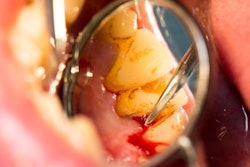
A new staging and grading system for periodontitis and classifying peri-implant diseases and conditions is one of the highlights of a publication on June 21 from the proceedings of an international workshop on periodontal disease by the American Academy of Periodontology (AAP).
The 2017 World Workshop on the Classification of Periodontal and Peri-Implant Diseases and Conditions brought together more than 100 experts to provide an update to the last workshop, held in 1999. The publication of the proceedings includes the first classification for peri-implant diseases (Journal of Periodontology, June 2018, Vol. 89:suppl 1, pp. S1-S8).
 Kenneth Kornman, DDS, PhD, editor in chief of the Journal of Periodontology.
Kenneth Kornman, DDS, PhD, editor in chief of the Journal of Periodontology."The new classification of periodontal disease is the first change in two decades in clinical classification of this very common disease," Kenneth Kornman, DDS, PhD, told DrBicuspid.com in an exclusive email interview. "The new classification also helps to identify the periodontitis cases that are more likely to respond predictably to standard periodontal treatment principles."
Dr. Kornman is the editor in chief of the Journal of Periodontology and a member of the workshop's organizing committee.
The complete suite of review papers and consensus reports are available in the June 2018 issue of the journal.
Periodontitis staging
The new classification has four categories of periodontitis staging, which are determined by a number of variables and range from stage I (least severe) to stage IV (most severe).
The publication also introduces three levels of periodontitis grading. The grades consider a patient's overall health status and their risk factors:
“The new classification of periodontal disease is the first change in two decades in clinical classification of this very common disease.”
- Grade A indicates a low risk of progression.
- Grade B indicates a moderate risk of progression.
- Grade C indicates a high risk of progression.
"The new staging and grading system provides a structure for treatment planning and for monitoring a patient's response to therapy," Dr. Kornman stated in an AAP press release.
The new classification system acknowledges that about 20% to 25% of adults have multiple factors, such as smoking and uncontrolled diabetes, that influence the severity and clinical characteristics of their specific case, he noted.
"The classification system helps to clarify for the dentist and the patient whether a specific case is likely to respond predictably to regular professional dental plaque removal and good home care, or is likely to require more complex treatment and maintenance care," he told DrBicuspid.com. "The new classification also should help identify patients at an early stage of the disease but with risk factors that may help guide more intensive preventive care and monitoring.
Implant dentistry
A peri-implant disease and condition classification is included for the first time. Implant dentistry is a major component of treatment planning and patient care, Dr. Kornman noted.
"And just like tissues that support natural teeth, the bone and soft tissues surrounding dental implants are susceptible to inflammation-driven complications without proper care and management," he stated.
One of the aims of the workshop was to provide all dentists with increased information to guide and improve their patient care, Dr. Kornman wrote.
"The new approach expands the conversation the dentist can have with the patient relative to their specific case of periodontitis, and why their case may require more frequent cleaning and monitoring than others," Dr. Kornman told DrBicuspid.com. "The new classification also helps to identify the periodontitis cases that are more likely to respond predictably to standard periodontal treatment principles."
Disclaimer
The workshop was presented with support from the AAP Foundation, Colgate, Johnson & Johnson Consumer, Geistlich Biomaterials, Sunstar, and Procter & Gamble Professional Oral Health. No editorial fee was paid to DrBicuspid.com for this editorial feature.



















